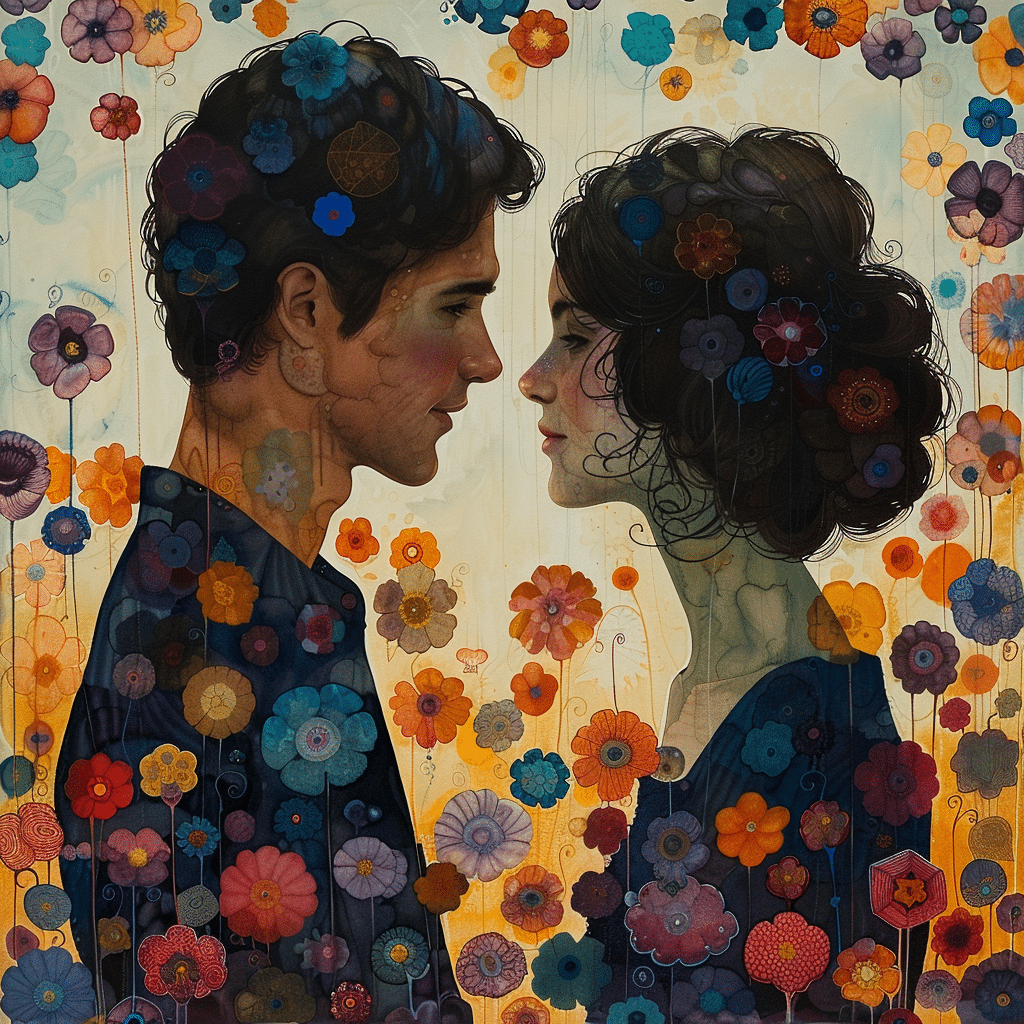When you think of love encapsulated within the confines of a story, theoretical physicist Elsie Hannaway’s not your typical cupid’s muse. Ali Hazelwood’s latest rollercoaster of the heart, “Love, Theoretically,” invites readers to dissect ‘love theoretically’, a notion much in vein of academic pursuit as it is a fluttering of the heart. Launched as an electrifying installment to “The STEMinist Novellas,” Hazelwood’s narrative web weaves contemporary romance with scientific inquiry.
In this exploration, we’re seeking the kernels of truth in ‘love theoretically’, armed with a magnifying glass for love’s concepts crafted in the lab of Hazelwood’s poignant prose. Here’s to falling headfirst into Hazelwood’s complex tapestry of romance, where the intellect meets the intimate, and theories aren’t just for textbooks. It’s time to throw the proverbial lab coat on and test the hypothesis: Can crazy love theories stand up under the microscope of Ali Hazelwood’s tale?
Love Theoretically: An Exploration into Ali Hazelwood’s Perspectives on Romance
Widely recognized for her ability to blend the rigor of academia with the throes of heartache and humor, Ali Hazelwood’s body of work stands as a testament to her unique take on the romance genre. “Love, Theoretically,” the writer’s third act of passion and particle physics, gifts readers with a narrative that defies the typical boundaries of romance. Here, Elsie Hannaway isn’t spellbound by spontaneous attraction; instead, love encroaches through empirical evidence and experimental engagement.
Hazelwood’s treatments of love theories as more than mere plot chords but as quintessential elements foster a layered understanding of romantic relationships. She gives us characters that don’t just fall in love; they stumble upon it after a series of meticulously plotted graphs and charts.

The Experiment of Proximity: Hazelwood’s Use of Spatial Dynamics in Love
Ever heard of the old adage, “keep your friends close and your potential love interests closer”? This plays out in Hazelwood’s narratives, except here, it’s not just rom-com fluff; it’s an analytical look at proximity’s role in emotional concoction. Elsie and her co-protagonist (spoilers withheld out of sheer mercy) become involuntarily shackled by shared spaces—labs, conferences, and the like—only to find a rapport blossoming beyond their blueprints.
In these scenes, proximity is more than happenstance; it’s the force kindling the slow-burn romance that Hazelwood is celebrated for.
| **Aspect** | **Details** |
|---|---|
| Title | Love, Theoretically |
| Author | Ali Hazelwood |
| Release Date | October 24, 2023 |
| Series Name | The STEMinist Novellas |
| Previous Installments | 1. The Love Hypothesis (2021) |
| Genre | Romance |
| Main Character | Elsie Hannaway |
| Occupation | Adjunct Professor in Theoretical Physics, specializing in Thermodynamics |
| Tropes | – Academic rivals to lovers |
| – Enemies to lovers (moderately) | |
| – Brother’s fake girlfriend | |
| – Guy falls first | |
| Spice Factor | Graphic sexual content present (advised to skip chapters 19-22 for a milder experience) |
| Target Audience | Adult romance readers, particularly those interested in academic settings and STEM-themed narratives |
| Standout Features | – Incorporation of theoretical physics as a backdrop |
| – Strong female protagonist in STEM | |
| Pricing | Pricing typically similar to contemporary novellas (exact price to be determined by retailers and edition) |
| Where to Purchase | Available at major book retailers, both in-store and online |
| Benefits | – Enjoyment for fans of romance with an intellectual twist |
| – Representation of women in science | |
| – Contemporary romantic storyline intertwined with academic and scientific elements |
Conditioning Hearts: Operant Conditioning in Romantic Evolution
You wouldn’t typically flirt with the idea of combining B.F. Skinner’s operant conditioning with tender embraces. Yet, Hazelwood spins a yarn where behavioral reinforcement isn’t just for pigeons. Our characters navigate the peaks and troughs of affection, finding that little affirmations or admonishments do lead to ‘conditioned’ responses.
Hazelwood uses clever dialogue and situations to demonstrate that the essence of love can be compared to a learning process—one with its hypotheses, trials, and inevitably, errors.

Attachment Styles Defined Through Character Archetypes
Elsie’s thrills and theoretical spills on the convoluted path to romance symbolize more than narrative sparks—they reflect sound psychological paradigms. Hazelwood allocates her characters along the spectrum of attachment styles, turning them into relatable models of secure, anxious, avoidant, and disorganized tendencies.
Hazelwood, in ‘love theoretically’, captures the nuance that binds heartstrings to attachment theories, with characters that readers can’t just appreciate, but appreciate definition.
The Chemical Reaction of Love: Neurotransmitters at Play in Hazelwood’s World
Dopamine, oxytocin, and serotonin aren’t just buzzwords in Hazelwood’s cocktail of love; they’re clandestine agents driving the narrative forward. The characters aren’t simply swept up in whirlwind romances; their emotions are underpinned by chemical conspiracies.
In Hazelwood’s inspired tales, these biochemical players strike chords with our own experiences, sometimes sweet as serotonin, other times the pure adrenaline of a high-stakes love.
Love as a Narrative Drive: Exploring Motivation Theory in Character Decisions
“Love, Theoretically” charts the course of intrinsic and extrinsic motivations that propel characters toward love’s enigmatic conclusions. Hazelwood taps into their deepest desires, mapping out their individual and communal quests like it’s an algorithm coded for passion.
By dissecting their romantic odysseys against such intricate motivational backdrops, Hazelwood crafts multi-dimensional beings driven by more than just heartthrobs or storyline conveniences.
The Principle of Scarcity and Desire Intertwined in Fictional Relationships
What happens when a professor’s time is as scarce as a specific edition of a physics journal? Desire inflates, and Hazelwood’s characters are no strangers to this rule. The scarcity principle plays a pivotal role, turning the once accessible into forbidden fruit dappled with the dew of yearning.
Hazelwood’s use of scarcity isn’t crafted out of hollow dramatics; it’s a meticulous study in how what we can’t have often becomes what we chase, sometimes to our own narrative downfall.
Risk and Reward in Love: Game Theory within Complex Relationships
Elsie Hannaway navigates not just thermodynamics but the dynamics of love as if it’s the most cerebral game of chicken. Game theory isn’t just for political simulations in Hazelwood’s realm; it’s the bedrock of strategic decision-making in relationships.
The author masterfully weaves the complexities of game theory into the frays of romance, bestowing upon the narrative a credibility that’s as intricate as it is intimate.
Conclusion: The Multifaceted Equations of Love in Ali Hazelwood’s Fiction
Love, even when ‘love theoretically’ dissected, parsed, and diagrammed within an inch of its life, remains a mysteriously human phenomenon. Ali Hazelwood’s “Love, Theoretically” reaffirms that romance, even in its most preposterously scientific garb, thrives in the chaos of theory just as much as in the warmth of practiced reality. Hazelwood writes not just of the science of affection but of its artistry and unfathomable depth.
Through the permutations and combinations of love theories, Hazelwood’s work emerges as a compendium of the myriad ways love manifests within and between individuals. Whether it’s the proximity-induced serendipity, the behavioral tango of punishment and reward, or the emotional roller-coaster buoyed by neurotransmitters, Hazelwood encapsulates the universal quest for connection.
It’s a novel defiance against the backdrop of the sterile, algorithm-driven romantic predictions—a primal scream that even in the realm of rigorous analysis, love cannot be wholly quantified. Hazelwood teaches us that love, in all of its unpredictable glory, can be “theoretically” posited but never truly tamed. And as Elsie and her counterparts venture into the unknown terrains of heart and hypothesis, they delineate a truth: that concocting the perfect love formula may be a pipe dream, but the pursuit? Splendidly worth every variable.
Exploring Love Theoretically in Ali Hazelwood’s Whirlwind Romance
Who knew that delving deep into Ali Hazelwood’s captivating romance tale could reveal love theories that are just as mind-boggling as they are heart-fluttering? Buckle up, folks—it’s time to unravel the mysteries of attraction and affection with some playful trivia and remarkable facts that could only be found when we explore ‘love theoretically’.
The Science of Attraction
First things first, did you know that love can be a real experiment? Picture our protagonists donning lab coats and goggles, because the chemistry between them is more explosive than a high school science project gone awry. Love, it turns out, isn’t just about gooey feelings; it’s a complex equation where pheromones, interests, and traits all intermingle. It’s enough to make you wonder about the Craig Robinson of love connections—unseen yet instrumental in sparking that initial sizzle!
From Fiction to Reality: Can You Cash In on Love?
Talk about a plot twist! It’s as though our characters could step out of the page and shake up the real world of romance. Imagine yourself stumbling upon a love as rich and straightforward as a cash buyer For Homes—no( complicated contracts, just a clear, immediate connection. Now wouldn’t that be a dream come true in today’s dizzying dating landscape?
The Ageless Enigma of Love
Let’s talk about time for a sec—how does it tangle with love theoretically? If you’re as confounded as I am, think of How old Is Jennifer aniston and yet, she remains an ageless icon of love and vitality in Hollywood. Love in Hazelwood’s narrative seems to defy age, echoing the timeless allure of a love story that survives against all odds—much like Aniston’s enduring charisma.
Love’s Epic Adventures on Screen
Ever feel like you’re living vicariously through the sweeping romances you watch on TV? Taking cues from shows like Outlander season 8, Hazelwood’s lovers embark on their epic journey. It’s as if they’re stepping through the stones of Craigh na Dun, navigating the tempests of time, and kindling a love that could spark a revolution—or at least, a few racing hearts among us readers.
The Ensemble Cast of Love’s Theatre
Okay, bear with me—imagine our love story’s side characters as brilliant as a star-studded cast, peppering the plot with their quirky charm. Think of Meredith Monroe playing the supportive best friend, or a wise mentor with the gravitas of a Nick Robinson. Speaking of which, the wide array of Nick Robinson Movies And tv Shows offers a glimpse into the layered performances that could be reflected in our story’s secondary characters, each bringing depth and richness to this love tapestry.
Translating Love from Page to PC
And hey, isn’t reading about love akin to playing your favorite game? You become so engrossed, you hardly notice the hours slipping by. Just as players are eager to figure out how to deploy Totk on PC for an improved gaming experience, readers dissect Hazelwood’s text, hunting for hidden meanings and love hacks. Get ready to be as obsessed with unraveling ‘love theoretically’ as gamers are with TOTK on PC, because once you start, you just can’t stop.
So there you have it—a glimpse into the whimsical, profound, and utterly enchanting world of Hazelwood’s love theories. Whether it’s a matter of science, fate, or a cosmic Craig Robinson-esque force, one thing’s for sure: love theoretically isn’t just a concept, it’s an adventure—one that keeps us coming back for more, page after page. Now, aren’t you just itching to dive back in and experience it all over again?

Does Love, Theoretically have spicy scenes?
– Whoa, buckle up for “Love, Theoretically” because spicy is putting it mildly! If you’re thumbing through the pages expecting a cutesy love story, heads up — there’s some graphic sexual content that’ll make your cheeks burn. To dodge the racy bits, chapters 19-22 are the ones to skip. You’ve been warned!
Is Love, Theoretically the sequel?
– Oh, you betcha “Love, Theoretically” isn’t flying solo – it’s part of a scoreboard! This read is the third installment in Ali Hazelwood’s “The STEMinist Novellas” series, taking off after “The Love Hypothesis.” Think of it as the cherry on top of an academia-flavored treat that started back in 2021.
What trope is Love, Theoretically?
– Tropes galore in “Love, Theoretically”! Think of it as a romantic recipe with a dash of academic rivals to lovers, a pinch of enemies to lovers (sorta, but don’t put your money on it), and a spoonful of the classic brother’s fake girlfriend scenario. And oh boy, the guy falls first – talk about a swoonfest!
What is Love, Theoretically about summary?
– So, what’s the skinny on “Love, Theoretically”? Picture Elsie Hannaway, a theoretical physicist and adjunct professor, juggling thermodynamics and a whirlwind life. If you’re nodding off at ‘thermodynamics,’ think high-flying science shenanigans. But don’t fret; it’s not rocket science to follow along, even if you’re not the next Einstein.
Is Greg asexual in Love, Theoretically?
– As for Greg in “Love, Theoretically,” the details on whether he’s asexual aren’t spilled in the book. But hey, diversity in characters is the spice of literature, right?
What is the age gap between Olive and Adam?
– Olive and Adam have got everyone’s eyebrows raised with their age difference – it’s a topic that’s got readers flipping pages wanting the lowdown. But in “Love, Theoretically”? They’re MIA, so the gossip about their age gap doesn’t make a cameo.
Do Adam and Olive appear in Love, Theoretically?
– If you’re hoping to catch a glimpse of Adam and Olive from “The Love Hypothesis” in “Love, Theoretically,” I hate to break it to you, but they’re chillin’ offstage this time around.
Is Love, Theoretically slow burn?
– “Slow burn” is practically the middle name of “Love, Theoretically,” and trust me, it sizzles! The tension simmers so slow and steady, you’ll be on tenterhooks waiting for that boil!
Is Love, Theoretically worth reading?
– If you’re on the fence about “Love, Theoretically,” climb down and grab a copy! Whether it’s worth your time hinges on your love for brainy heroines, quirky banter, and yes, a good helping of romance with a scientific twist.
Is Love, Theoretically explicit?
– “Love, Theoretically” doesn’t beat around the bush – it’s got parts that’ll make you fan yourself. Mark my words, chapters 19-22 don’t hold back and are definitely not for the faint-hearted.
Does Elsie have diabetes in Love, Theoretically?
– The word on the street – or in the pages of “Love, Theoretically” – about Elsie’s health, like diabetes, isn’t dished out. The focus is more on the heat of the moment, not a medical chart!
What does ape mean in Love, Theoretically?
– “Ape” in “Love, Theoretically”? Now that’s one for the cryptologists. It’s not used as a key phrase, so you might be scratching your head for a bit unless it pops up as slang or an acronym!
Is there a third act breakup in Love, Theoretically?
– A third act breakup in “Love, Theoretically”? C’mon, no spoilers here! You gotta read it to find out if the love train derails before reaching its destination.
Is Icebreaker spicy?
– “Icebreaker” spicy? Without spilling too much tea, let’s just say if “Love, Theoretically” turned up the heat, “Icebreaker” isn’t exactly a cold shower either.
Is Love, Theoretically a standalone?
– Is “Love, Theoretically” flying solo? Yup, this baby can stand on its own two feet! It’s part of a series but packs a punch all by itself – no need to play catch-up with the other books!
















